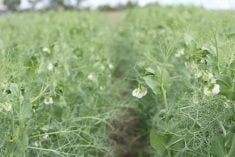Currency fluctuations are pushing down the price of crops prairie farmers grow.The euro and loonie have ganged up to beat down current and deferred prices since the Greek debt crisis began spilling out of Europe into the world’s stock and commodity markets.”It’s Greece,” Joe Victor of Allendale Inc. in McHenry, Illinois, said about the slump in North American crop prices.”The (U.S.) dollar’s higher. The stock market is lower. Gold is higher. Oil is lower.”Money is fleeing “risky” commodities and equities and moving into “safe” investments, with crops generally seen as slightly more on the risky side than the safe side.However, the biggest impact appears to be made by currencies, which have suddenly shifted relative crop values for farmers around the world.Europe’s fiscal turmoil has caused the euro to plunge, the U.S. dollar to rise and the Canadian dollar to weaken a little versus the greenback.For Canadians, the loonie’s recent decline to 96 cents from parity has cushioned the slump in U.S. dollar denominated crop prices, but not eliminated it. For instance, the ICE Futures Canada November canola contract has dropped two percent from about $391 per tonne at the start of May to about $383 early this week. Chicago Board of Trade soybeans dropped six percent to $9.16 from about $9.75 per bushel in the same period. Soybean oil fell 4.8 percent to 37.11 cents per pound.However, canola futures prices on the European Matif exchange have risen slightly in that period thanks to the devalued euro.Overall, crop prices in most of the world are weakening. The exception is in European countries that use the euro because of the rapid depreciation of their money. The euro hit a four year low May 17.Victor said global crop prices are weakening not only because of the fear of weakening demand caused by the Greek financial meltdown and its contagious effects but also because most American crops are off to a great start this spring.
Read Also

Prairies have variable soil moisture conditions
The dry weather in the west was welcome for preserving grain quality and advancing harvest, but it has resulted in very dry soil moisture conditions.















